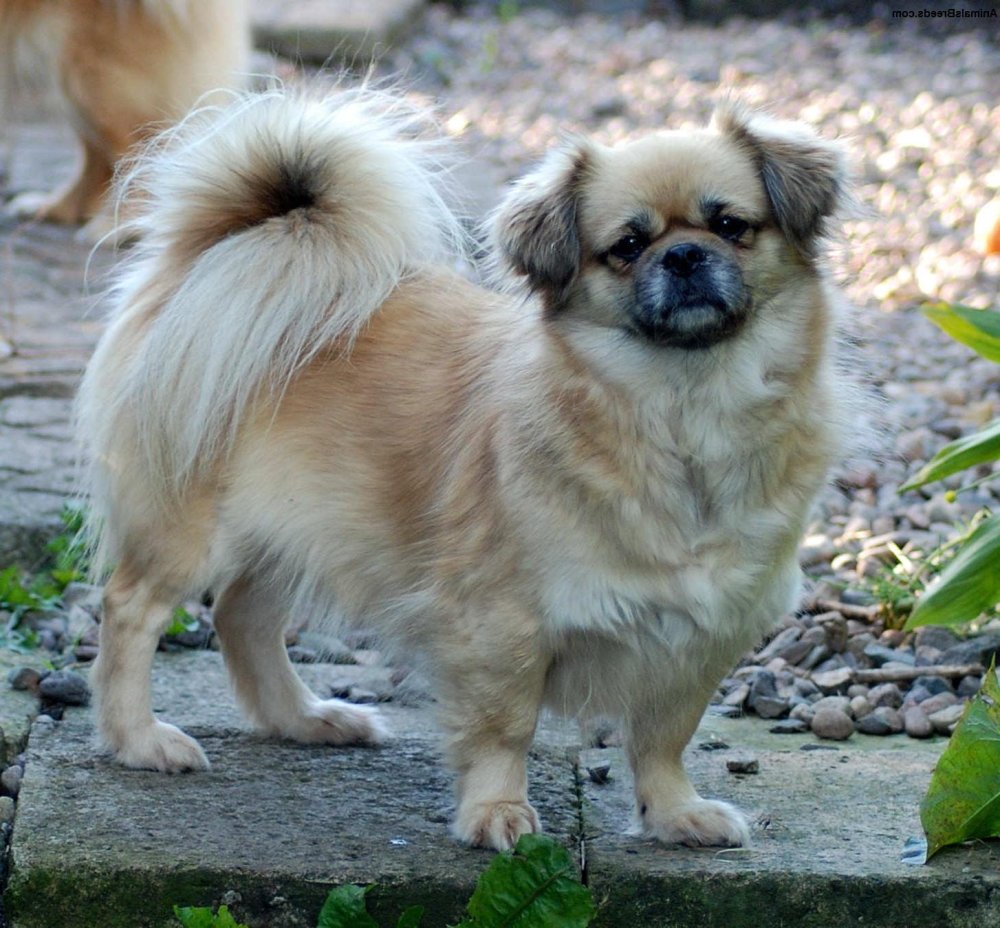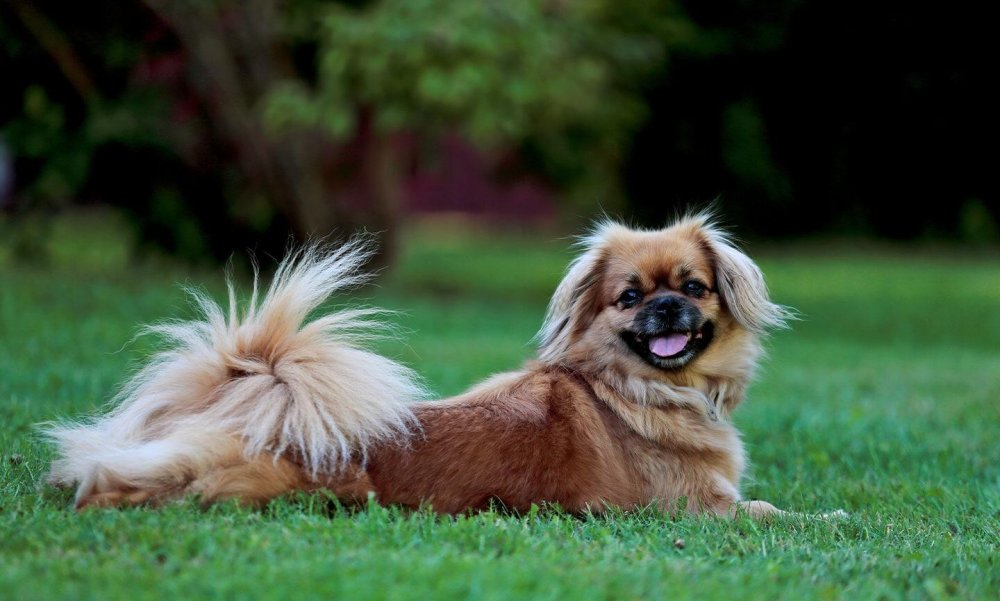- Breed Category: Companion dog
- Country of Origin: Tibet
- Average Height: 25 cm (10 in)
- Average Weight: 4-7 kg (9-15 lbs)
- Average Life Span: 12-15 years
- Grooming Requirements: Weekly brushing needed
- Exercise Requirements: Moderate daily exercise
- Coat Type: Silky double coat
- Coat Color Variations: Various colours, often golden
- Shedding Level: Moderate shedding
- Ear Type: Pendant ears
- Tail Type: Curled over back
- Temperament: Alert, independent, affectionate
- Intelligence Level: High intelligence
- Barking Tendency: Moderate barking
- Compatibility with Children: Good with older children
- Compatibility with Other Pets: Generally good with other pets
- Training Ease: Can be stubborn
- Common Health Issues: Progressive retinal atrophy, allergies
- Dietary Needs: High-quality dog food
- Energy Level: Moderate energy
- Drooling Tendency: Low drooling
- Sensitivity to Weather: Sensitive to heat
- Overall Maintenance Level: Moderate maintenance
- Original Purpose: Monastery watchdog
- Year of Recognition by Kennel Clubs: 1983
- Apartment Friendly: Yes, suitable for apartments
- Best Suited For: Families, singles, seniors
- Cost of Ownership: Moderate cost
- Unique Traits: Lion-like mane, expressive eyes
- Cultural Significance: Sacred in Tibetan monasteries
- Popularity Rank: Moderately popular
Think all small dogs are just lap warmers? The Tibetan Spaniel might surprise you. This breed, with its lion-like mane and confident demeanor, is more than just a pretty face. Known for their intelligence and independence, Tibetan Spaniels have a rich history that dates back centuries. Originally bred by Tibetan monks, these dogs served as both companions and watchdogs in monasteries. Their keen eyesight and alert nature made them perfect for spotting intruders from high perches. This article aims to delve into the unique characteristics, fascinating history, and essential care tips for the Tibetan Spaniel. Whether you’re considering adding one to your family or just curious, you’ll find everything you need to know right here.
The Tibetan Spaniel: A Breed with a Rich Heritage

Early Development of the Breed
The Tibetan Spaniel’s roots trace back to ancient times in the Himalayan region. These dogs were carefully bred by Tibetan monks, who valued their intelligence and loyalty. Unlike many other breeds, Tibetan Spaniels were not developed for hunting or herding. Instead, they were cherished for their companionship and their ability to serve as vigilant watchdogs.
Role in Tibetan Monasteries
In the serene and spiritual environment of Tibetan monasteries, these dogs played a crucial role. They were often found perched on monastery walls, using their sharp eyesight to spot any approaching strangers. Their alertness and keen senses made them invaluable to the monks, who relied on them for early warnings of potential threats.
Key Historical Figures and Cultural Significance
Throughout history, Tibetan Spaniels have been associated with nobility and spirituality. They were often gifted to Chinese emperors and other dignitaries, symbolising peace and goodwill. This cultural exchange helped spread their popularity beyond Tibet, cementing their status as a breed of significance.
Physical Characteristics
With their distinctive lion-like mane and expressive eyes, Tibetan Spaniels are truly a sight to behold. They are small yet sturdy, with a silky double coat that comes in a variety of colours. Their unique appearance, combined with their confident and independent nature, makes them stand out in any crowd.
Appearance and Unique Traits
Tibetan Spaniels are small but mighty, with a compact size that belies their bold personality. Their silky double coat can be found in a range of colours, from golden to black, often with striking white markings. This variety adds to their charm, making each one unique. But what really sets them apart is their lion-like mane, a feature that gives them a regal appearance. Their expressive eyes are full of intelligence and curiosity, always on the lookout for something interesting.
Temperament and Behaviour
These dogs are known for their independent spirit and intelligence. They’re not your typical lap dog, although they do enjoy a good cuddle. Tibetan Spaniels are alert and watchful, making them excellent watchdogs. They’re also quite playful and enjoy engaging with their human companions. While they can be a bit aloof with strangers, they form strong bonds with their families, showing loyalty and affection in their own unique way.
Personality and Suitability as a Family Pet

Typical Personality Traits
Tibetan Spaniels are a delightful mix of affectionate, intelligent, and independent. They have a knack for understanding their human companions, often displaying a keen sense of empathy. While they enjoy being close to their family, they also appreciate their own space, making them a great fit for those who value a bit of independence in their pets.
Suitability as a Family Pet
These dogs are well-suited to family life, offering companionship without being overly demanding. Their size and temperament make them adaptable to various living situations, whether it’s a bustling household or a quieter environment. They thrive on interaction and are happiest when they feel like part of the family.
Interaction with Children and Other Animals
Tibetan Spaniels generally get along well with children, especially if they’re raised together. Their playful nature makes them great playmates, though supervision is always recommended with younger kids. They can coexist peacefully with other animals, but early socialisation is key to ensuring harmonious relationships.
Training and Exercise Needs
Training a Tibetan Spaniel can be a rewarding experience, thanks to their intelligence. They respond well to positive reinforcement and enjoy learning new tricks. Regular exercise is important, but they don’t require extensive workouts. A daily walk and some playtime will keep them happy and healthy.
Training, Exercise, and Health of the Tibetan Spaniel

Importance of Early Training and Socialisation
Getting your Tibetan Spaniel started with training and socialisation early on is crucial. These dogs are smart and independent, so introducing them to different environments, people, and other animals while they’re young helps them grow into well-rounded adults. It’s all about building confidence and reducing any potential anxiety.
Recommended Training Techniques
When it comes to training, positive reinforcement is the way to go. Tibetan Spaniels respond well to treats, praise, and play. Keep sessions short and fun to maintain their interest. Consistency is key, so make sure everyone in the household is on the same page with commands and rules.
Daily Exercise Requirements and Activities They Enjoy
These little guys don’t need a marathon run, but they do enjoy a daily walk and some playtime. A game of fetch or a romp in the backyard can do wonders. They love activities that engage their minds, so puzzle toys or training games are a hit.
Health and Lifespan
Tibetan Spaniels are generally healthy, with a lifespan of around 12 to 15 years. Regular vet check-ups, a balanced diet, and keeping an eye on their weight will help them live a long, happy life. Like any breed, they can be prone to certain health issues, so staying informed and proactive is always a good idea.
Health and Care for Tibetan Spaniels

Common Health Issues
Tibetan Spaniels are generally healthy, but like any breed, they can be prone to certain health issues. Eye problems, such as progressive retinal atrophy, and patellar luxation are some concerns to watch out for. Regular vet check-ups can help catch these early.
Average Lifespan and Health Tips
With proper care, these dogs can live between 12 to 15 years. A balanced diet, regular exercise, and mental stimulation are key to keeping them healthy. Monitoring their weight is important, as obesity can lead to other health problems.
Preventative Care Recommendations
Routine vaccinations, flea and tick prevention, and dental care are essential. Regular grooming helps keep their coat in top condition and provides an opportunity to check for any skin issues or parasites.
Grooming and Maintenance
Their silky double coat requires regular brushing to prevent matting and reduce shedding. Bathing should be done as needed, but not too frequently to avoid stripping natural oils. Regular nail trimming and ear cleaning are also important parts of their grooming routine.
Coat Care and Grooming for Tibetan Spaniels

Coat Care and Grooming Routines
Keeping a Tibetan Spaniel’s coat in top shape is all about regular maintenance. Their silky double coat needs brushing a few times a week to prevent tangles and matting. A slicker brush or a comb works wonders for this. Regular grooming not only keeps them looking their best but also helps distribute natural oils, keeping their skin healthy.
Shedding and Seasonal Grooming Tips
These dogs do shed, especially during seasonal changes. During these times, more frequent brushing can help manage the extra hair. A good deshedding tool can be handy to remove loose fur. Bathing should be done as needed, but not too often, to avoid stripping their coat of essential oils.
Diet and Nutrition
A balanced diet is crucial for the overall health of a Tibetan Spaniel. High-quality dog food, appropriate for their age and activity level, is recommended. Keep an eye on portion sizes to prevent obesity, which can lead to other health issues. Fresh water should always be available, and occasional treats can be given, but moderation is key.
Nutritional Needs and Feeding Tips for Tibetan Spaniels

Nutritional Needs for Optimal Health
Feeding your Tibetan Spaniel a balanced diet is key to their health and happiness. Look for high-quality dog food that matches their age, size, and activity level. Protein is essential for muscle maintenance, while healthy fats support their energy needs and coat health. Don’t forget about vitamins and minerals, which are crucial for overall well-being.
Foods to Include and Avoid
Include lean meats, fish, and vegetables in their diet for a well-rounded meal. Avoid foods high in fat and sugar, as well as those that are toxic to dogs, like chocolate, grapes, and onions. Always check with your vet if you’re unsure about a particular food.
Feeding Schedules and Portion Recommendations
Stick to a regular feeding schedule to help maintain their digestive health. Typically, two meals a day works well for adult Tibetan Spaniels. Portion sizes depend on their weight and activity level, so consult your vet for personalised advice. Remember, overfeeding can lead to obesity, which is a common issue in small breeds.
Fun Facts and Trivia
Did you know Tibetan Spaniels were once considered sacred by Tibetan monks? They were often given as gifts to Chinese royalty. Despite their small size, these dogs have a big personality and are known for their lion-like mane, which adds to their regal appearance.
Interesting Tidbits and Famous Tibetan Spaniels

Interesting Tidbits about the Breed
Tibetan Spaniels are not just charming companions; they have some intriguing quirks. For instance, they have a unique way of showing affection by rubbing their faces against their loved ones, a behaviour known as “chinning.” This breed is also known for its cat-like agility, often seen perching on high furniture to survey their surroundings. Their history as monastery watchdogs has given them a natural instinct to be alert and observant, making them excellent at detecting changes in their environment.
Famous Tibetan Spaniels in Media or History
While Tibetan Spaniels may not be as widely recognised in media as some other breeds, they have made their mark in history. One notable Tibetan Spaniel was “Ch. Starlite’s A Little Bit of Heaven,” who won the Best in Show at the Westminster Kennel Club Dog Show in 1984. This victory brought attention to the breed’s elegance and charm. Additionally, Tibetan Spaniels have been featured in various books and documentaries about Tibetan culture, highlighting their role as cherished companions of monks and nobility.
Final Thoughts
The Tibetan Spaniel is a unique blend of charm and intelligence. This breed’s rich history and distinctive traits make it a fascinating companion. With their alert nature and affectionate demeanor, Tibetan Spaniels offer both companionship and a sense of security. Embracing their independent spirit and providing proper care can lead to a rewarding relationship. Consider welcoming a Tibetan Spaniel into your life and experience the joy of this remarkable breed.
